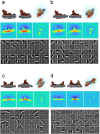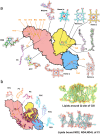High-resolution in situ structures of mammalian respiratory supercomplexes
- PMID: 38811722
- PMCID: PMC11222160
- DOI: 10.1038/s41586-024-07488-9
High-resolution in situ structures of mammalian respiratory supercomplexes
Abstract
Mitochondria play a pivotal part in ATP energy production through oxidative phosphorylation, which occurs within the inner membrane through a series of respiratory complexes1-4. Despite extensive in vitro structural studies, determining the atomic details of their molecular mechanisms in physiological states remains a major challenge, primarily because of loss of the native environment during purification. Here we directly image porcine mitochondria using an in situ cryo-electron microscopy approach. This enables us to determine the structures of various high-order assemblies of respiratory supercomplexes in their native states. We identify four main supercomplex organizations: I1III2IV1, I1III2IV2, I2III2IV2 and I2III4IV2, which potentially expand into higher-order arrays on the inner membranes. These diverse supercomplexes are largely formed by 'protein-lipids-protein' interactions, which in turn have a substantial impact on the local geometry of the surrounding membranes. Our in situ structures also capture numerous reactive intermediates within these respiratory supercomplexes, shedding light on the dynamic processes of the ubiquinone/ubiquinol exchange mechanism in complex I and the Q-cycle in complex III. Structural comparison of supercomplexes from mitochondria treated under different conditions indicates a possible correlation between conformational states of complexes I and III, probably in response to environmental changes. By preserving the native membrane environment, our approach enables structural studies of mitochondrial respiratory supercomplexes in reaction at high resolution across multiple scales, from atomic-level details to the broader subcellular context.
© 2024. The Author(s).
Conflict of interest statement
The authors declare no competing interests.
Figures














Similar articles
-
High-resolution In-situ Structures of Mammalian Mitochondrial Respiratory Supercomplexes in Reaction within Native Mitochondria.bioRxiv [Preprint]. 2024 Apr 3:2024.04.02.587796. doi: 10.1101/2024.04.02.587796. bioRxiv. 2024. PMID: 38617346 Free PMC article. Preprint.
-
Architecture of active mammalian respiratory chain supercomplexes.J Biol Chem. 2006 Jun 2;281(22):15370-5. doi: 10.1074/jbc.M513525200. Epub 2006 Mar 20. J Biol Chem. 2006. PMID: 16551638
-
Structure of a mitochondrial supercomplex formed by respiratory-chain complexes I and III.Proc Natl Acad Sci U S A. 2005 Mar 1;102(9):3225-9. doi: 10.1073/pnas.0408870102. Epub 2005 Feb 15. Proc Natl Acad Sci U S A. 2005. PMID: 15713802 Free PMC article.
-
Functional role of mitochondrial respiratory supercomplexes.Biochim Biophys Acta. 2014 Apr;1837(4):427-43. doi: 10.1016/j.bbabio.2013.11.002. Epub 2013 Nov 15. Biochim Biophys Acta. 2014. PMID: 24246637 Review.
-
The road to the structure of the mitochondrial respiratory chain supercomplex.Biochem Soc Trans. 2020 Apr 29;48(2):621-629. doi: 10.1042/BST20190930. Biochem Soc Trans. 2020. PMID: 32311046 Free PMC article. Review.
Cited by
-
Structure and organization of full-length epidermal growth factor receptor in extracellular vesicles by cryo-electron tomography.Proc Natl Acad Sci U S A. 2025 Jun 10;122(23):e2424678122. doi: 10.1073/pnas.2424678122. Epub 2025 Jun 2. Proc Natl Acad Sci U S A. 2025. PMID: 40455995
-
In situ structure determination of conformationally flexible targets using nextPYP.Nat Protoc. 2025 Aug 19:10.1038/s41596-025-01218-9. doi: 10.1038/s41596-025-01218-9. Online ahead of print. Nat Protoc. 2025. PMID: 40830298 Free PMC article. Review.
-
Quinone chemistry in respiratory complex I involves protonation of a conserved aspartic acid residue.FEBS Lett. 2024 Dec;598(23):2856-2865. doi: 10.1002/1873-3468.15013. Epub 2024 Sep 11. FEBS Lett. 2024. PMID: 39262040 Free PMC article.
-
Polyamine metabolism is dysregulated in COXFA4-related mitochondrial disease.HGG Adv. 2025 Apr 10;6(2):100418. doi: 10.1016/j.xhgg.2025.100418. Epub 2025 Feb 17. HGG Adv. 2025. PMID: 39967265 Free PMC article.
-
Flexibility and Hydration of the Qo Site Determine Multiple Pathways for Proton Transfer in Cytochrome bc1.J Chem Inf Model. 2025 Jun 23;65(12):6184-6197. doi: 10.1021/acs.jcim.5c00655. Epub 2025 Jun 10. J Chem Inf Model. 2025. PMID: 40492973 Free PMC article.
References
MeSH terms
Substances
Grants and funding
LinkOut - more resources
Full Text Sources
Molecular Biology Databases

